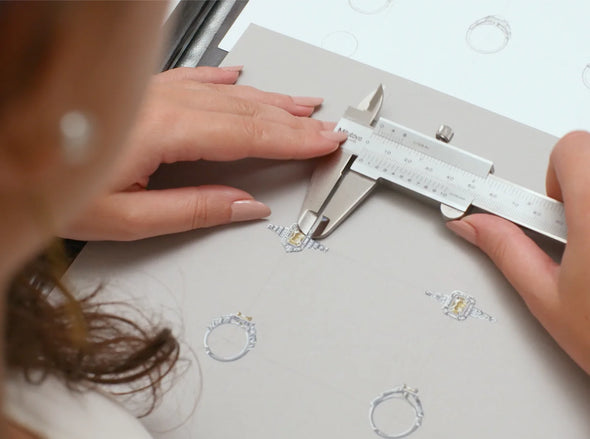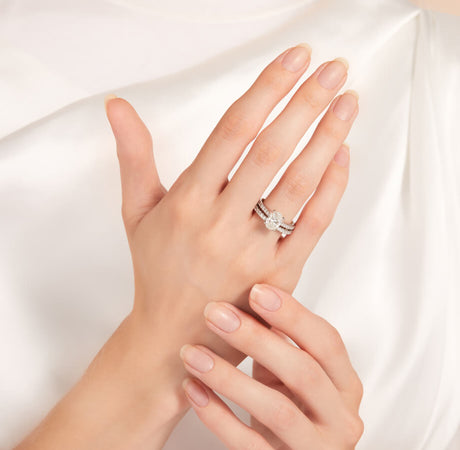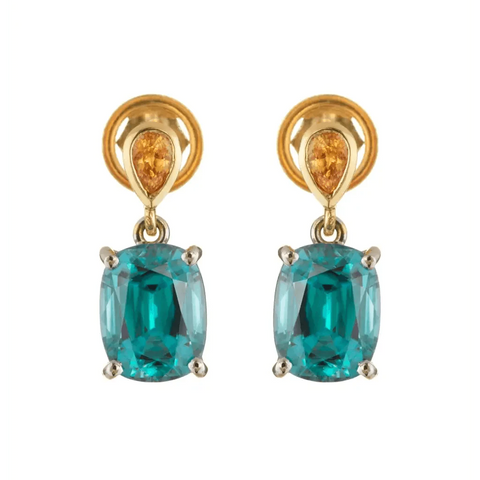From our GIA experts
Cushion Cut Guide
For those once-in-a-lifetime moments that deserve nothing less than timeless elegance, choosing the right symbol of love is a deeply personal journey. Cushion cut diamonds, with their soft curves and vintage charm, have captured hearts for generations. Beloved for their romantic appeal and enduring sparkle, they make a truly meaningful choice for proposals, engagements, and beyond. We’ve created this guide with heartfelt care for couples preparing to begin their forever with a touch of old-world beauty and modern brilliance.
Cushion 4cs
Choosing a Cushion Diamond: Factors to Consider
Choosing the perfect diamond is about more than sparkle—it's about finding a shape that speaks to your story. With its gentle curves and timeless silhouette, the cushion cut offers a unique blend of antique romance and modern sophistication. Whether you’re drawn to its soft glow or vintage appeal, this guide will walk you through everything you need to know to find the cushion cut diamond that feels just right for you.
The Best Ratio for a Cushion Cut Diamond
The length-to-width ratio plays a key role in the overall appearance of a cushion cut diamond. This ratio determines whether the diamond appears more square or rectangular—both of which offer distinctly different aesthetics. The ideal ratio for a square cushion cut typically falls between 1.00 and 1.05, while elongated cushion cuts look best in the 1.10 to 1.20 range. Your choice will depend on personal style and how the diamond complements the wearer's hand—elongated cushions can create a more slender look, while square cushions offer a balanced, classic feel.
Cushion Cut Guide
The cut quality is essential to the cushion diamond’s brilliance. Unlike round diamonds, cushion cuts don’t have standardized cut grades from most labs, so it’s important to assess proportions, symmetry, and overall light performance. A well-cut cushion diamond will have symmetrical facets, minimal "bow-tie" effect, and either a chunky or “crushed ice” facet pattern—depending on your visual preference. Always look for excellent polish and symmetry to ensure the stone performs at its best.
Cushion Colour Guide
Cushion cut diamonds tend to retain more body colour than round brilliants due to their deeper pavilion and larger facets. For this reason, many experts recommend choosing a colour grade of H or higher for a white gold or platinum setting, and J or above can still look beautiful in yellow or rose gold. As always, colour preference is subjective—some may even prefer the warmth of a lower colour grade for a vintage-inspired look.

How to choose a cushion diamond
Buying Guide
The cushion cut is a type of modified brilliant cut, meaning it maintains the same facet structure designed to maximize brilliance while showcasing a different silhouette. In this case, the classic round brilliant has been softened into a square or rectangular shape with rounded corners—resembling a cushion or pillow. As a member of the ‘fancy cut’ family, the cushion cut offers a unique alternative to traditional shapes, delivering exceptional sparkle with a romantic, vintage-inspired aesthetic.
-
Length-to-Width Ratio:
Cushion cut diamonds generally range from 1.00 to 1.05 for a classic square appearance, while 1.10 to 1.20 ratios produce a more elongated, rectangular look. Your choice depends largely on personal style and how the shape flatters the wearer’s hand.Facets:
Cushion cuts typically have 58 to 64 facets, depending on whether the stone is a standard or modified cushion brilliant. These facets can create either a more defined “chunky” brilliance or a softer “crushed ice” effect, each offering a distinct type of sparkle.Facet Pattern (Crushed Ice vs. Chunky):
Unlike some other cuts, cushion diamonds can vary significantly in how they reflect light. The “chunky” pattern shows broader flashes of light, while the “crushed ice” pattern creates a shimmering, more scattered brilliance. Neither is better—just different aesthetics to suit your preference.Depth and Pavilion:
Cushion cut diamonds often have deeper pavilions, which can enhance sparkle but may also hide some weight. Look for well-proportioned stones to ensure maximum light performance without sacrificing face-up size. -
Cut Quality:
Because cushion cuts don’t receive standardized cut grades from most labs, pay close attention to overall symmetry, depth, and table percentages. A well-cut cushion will have balanced proportions and excellent light performance, whether you prefer a “chunky” or “crushed ice” look.Colour and Clarity:
Cushion cuts tend to show more body colour due to their deeper pavilion, so opt for a colour grade of H or higher for a bright, white appearance—especially in white metal settings. In terms of clarity, VS2 or better is typically a safe choice, though SI1 stones can be eye-clean if well-selected.Settings:
Cushion cut diamonds pair beautifully with halo, solitaire, and vintage-style settings. If the stone has slightly rounded corners, a four-prong setting works well; for more square cushions with softened edges, double-claw or bezel settings can enhance both protection and aesthetics. -
Solitaire:
A classic solitaire setting allows the cushion cut diamond’s soft shape and vintage charm to shine. This minimal design emphasizes the stone's natural beauty and is perfect for those who prefer timeless elegance.Halo:
A halo of smaller diamonds surrounding the cushion cut enhances its sparkle and creates the illusion of a larger center stone. This setting also complements both square and elongated cushion shapes beautifully.Vintage-Inspired:
Cushion cuts pair exceptionally well with antique-style settings featuring milgrain details, filigree, or side stones. These designs highlight the diamond’s old-world romance and charm.Bezel Setting:
For a sleek, contemporary look, a bezel setting encases the cushion cut in a smooth metal rim. This style offers extra protection and a clean, modern silhouette.Three-Stone:
Framing the cushion cut with two side stones—such as tapered baguettes or smaller cushions—adds depth and symbolism, representing the past, present, and future of a relationship.

Enduring Beauty
History of Cushion Cut
The cushion cut diamond, also known as the “pillow cut,” dates back to the 18th century and was originally known as the old mine cut. Favoured during the Georgian and Victorian eras, it was designed to sparkle under candlelight, with soft, rounded corners and a romantic vintage feel. Though modern cushion cuts have evolved for greater brilliance, they retain the timeless charm that has captivated jewellery lovers for centuries.
Ring Styles & Inspiration
Meghan Markle’s iconic engagement ring, designed by Prince Harry, features a stunning cushion-cut center diamond sourced from Botswana, flanked by two round diamonds from Princess Diana’s personal collection. Set on a yellow gold band, the ring beautifully blends royal tradition with timeless elegance.
Sarah Jessica Parker also chose a cushion-cut diamond for her engagement ring from Matthew Broderick. The elongated cushion-cut stone, estimated between 7 and 8 carats, is set on a unique double gold band—perfectly reflecting her distinctive, fashion-forward style.


frequently asked questions
Unsure about anything? Find our frequently asked questions.
Can't find the answers your looking for? Our team is on hand from Monday to Friday, 10am - 5pm.
-
Yes, cushion cut diamonds are a timeless and versatile option for engagement rings. Their soft, rounded shape combines vintage charm with modern elegance, making them a popular choice for both classic and contemporary settings.
-
Elongated cushion cuts have a longer length-to-width ratio—typically between 1.10 and 1.20—giving them a more rectangular appearance. They can make the finger appear slimmer and often offer a larger face-up look compared to square cushions. Both styles offer beautiful sparkle, so the choice comes down to personal preference.
-
While cushion cuts may have slightly less brilliance than round brilliants, they still offer exceptional sparkle—especially when well-cut. You can choose between a “chunky” facet pattern for broader flashes or a “crushed ice” look for a more glittery, scattered sparkle.
-
Cushion cuts can reveal more color due to their deeper proportions, so a color grade of H or higher is recommended for white metals. For clarity, VS2 or eye-clean SI1 stones typically offer great value while maintaining beauty.

Bespoke Services
Design your own bespoke engagement rings and transform ideas into reality.
We specialise in made-to-order diamond engagement rings. Whether you recreate one of our classic designs or have an idea of your own.






